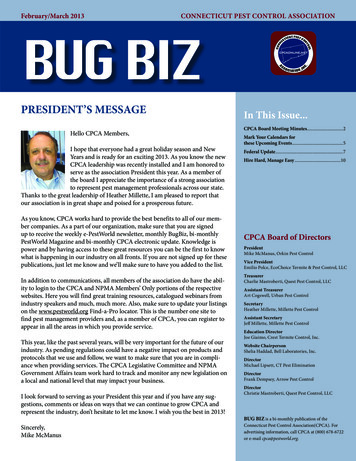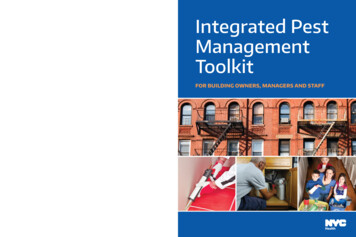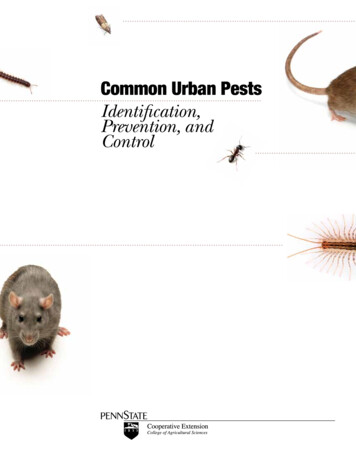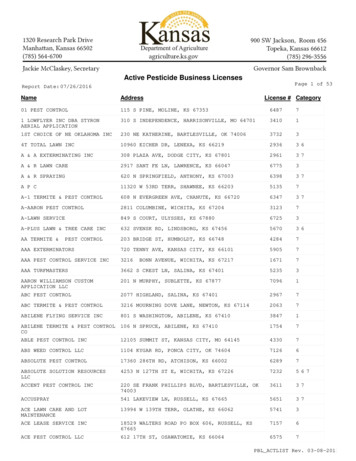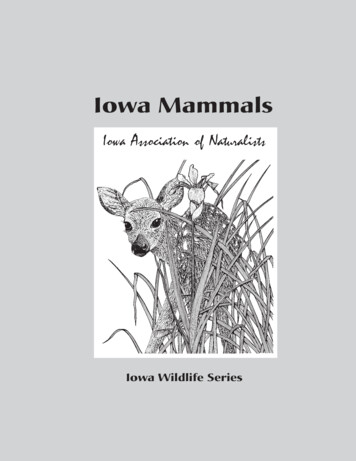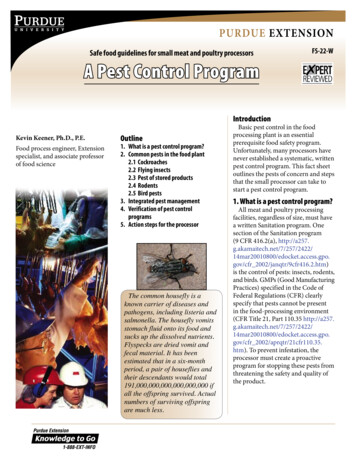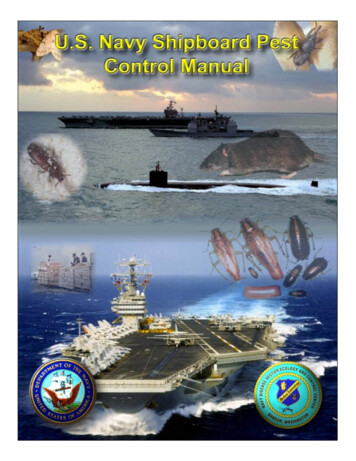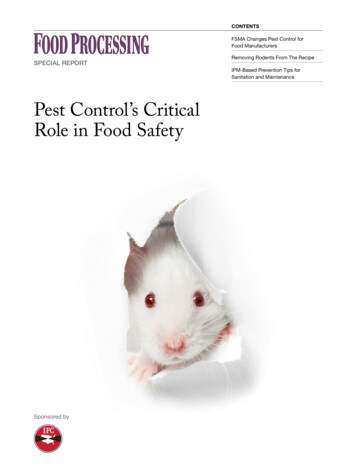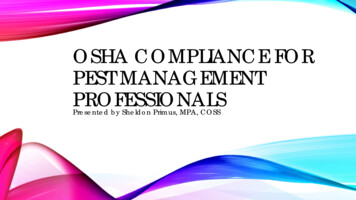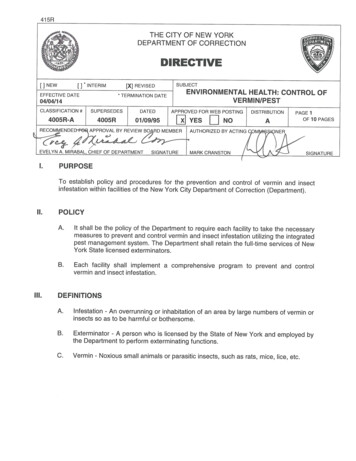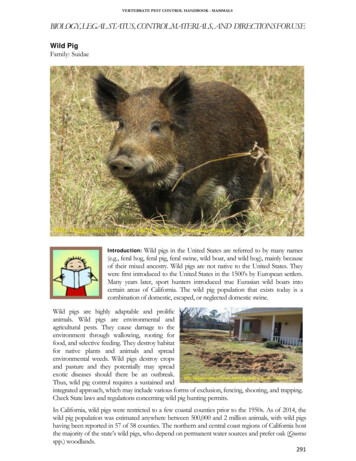
Transcription
VERTEBRATE PEST CONTROL HANDBOOK - MAMMALSBIOLOGY, LEGAL STATUS, CONTROL MATERIALS, AND DIRECTIONSFOR USEWild PigFamily: SuidaeBilly Higginbotham-Texas A&M AgriLife Extension ServiceWild pigs in the United States are referred to by many names(e.g., feral hog, feral pig, feral swine, wild boar, and wild hog), mainly becauseof their mixed ancestry. Wild pigs are not native to the United States. Theywere first introduced to the United States in the 1500’s by European settlers.Many years later, sport hunters introduced true Eurasian wild boars intocertain areas of California. The wild pig population that exists today is acombination of domestic, escaped, or neglected domestic swine.Introduction:Wild pigs are highly adaptable and prolificanimals. Wild pigs are environmental andagricultural pests. They cause damage to theenvironment through wallowing, rooting forfood, and selective feeding. They destroy habitatfor native plants and animals and spreadenvironmental weeds. Wild pigs destroy cropsand pasture and they potentially may spreadexotic diseases should there be an outbreak. Billy Higginbotham-Texas A&M AgriLife Extension ServiceThus, wild pig control requires a sustained andintegrated approach, which may include various forms of exclusion, fencing, shooting, and trapping.Check State laws and regulations concerning wild pig hunting permits.In California, wild pigs were restricted to a few coastal counties prior to the 1950s. As of 2014, thewild pig population was estimated anywhere between 500,000 and 2 million animals, with wild pigshaving been reported in 57 of 58 counties. The northern and central coast regions of California hostthe majority of the state’s wild pigs, who depend on permanent water sources and prefer oak (Quercusspp.) woodlands.291
VERTEBRATE PEST CONTROL HANDBOOK - MAMMALSIdentification: Wild pigs, because of their varied ancestry, come in all shapesand colors from gray, red, black, blond, spotted, and belted. Some look likedomestic pigs, others resemble Eurasian wild boars. All have small eyes,relatively small, erect ears, and a long, relatively flat snout. Wild pigs have athick coat of coarse, bristly fur; some are able to erect the fur along theirspine, lending them the common name “razorback”. Most wild pigs havelonger bristles than their domestic ancestors. Full grown males are usually200 lbs at adult weight, while full grown females weigh slightly less (around 175 lbs). While they cangrow larger than this, it is not considered common and would typically only occur through heavyconsumption of crops or livestock feed. Boars havefour sharp tusks that grow continuously, oftenreaching 5 inches before they break or become wornfrom use. The bottom tusks make formidableweapons. Boars use them for defense and toestablish dominance.Wild pigs live in matrilineal groups called soundersthat are led by a dominant female. While males arenomadic and are known to move about within theirhome range, females tend to stay in their familialgroups with 80% of females remaining with thesounder in which they were reared. Juvenile wild pigsoften exhibit dark coloration with horizontal stripes.Wild pigs are classified as game animals by the CaliforniaDepartment of Fish and Wildlife (CDFW), and as such, are subject tohunting regulations as outlined by CDFW policy. However, when wild pigsare damaging or destroying, or threatening to immediately damage or destroyland or property, the landowner, agent, or employee that “encounters” thedamage or threat, may take the offending wild pigs immediately. Manyrestrictions apply to such immediate take; specific details can be found at thefollowing website: ation.html.Legal Status:In cases other than above, any owner or tenant of land or property that is being damaged ordestroyed or is in danger of being damaged or destroyed by wild pigs may apply to CDFW for apermit to kill any such animals. In addition, where applicable, landowners can hunt wild pigs toreduce populations after obtaining a hunting license and wild pig hunting tags. Currently, the wildpig hunting season is year-round. Consult the Fish and Game hunting regulations for furtherinformation.Damage: Wild pigs impact ecosystems through their rooting, wallowing,foraging, and hunting, with a conservative annual estimate of 1.5 billion ineconomic damagenationally to agricultureand the environment.They are highlycompetitive for foodresources and have been known to drive cattleaway from supplement. Deer are also known tovacate an area, such as a water source, upon thearrival of wild pigs.Sedgwick University of California Natural ReserveTheir rooting behavior overturns and tills the soil, uprooting plants, exposing bare soil, and creatingopportunities for weeds to invade. They disturb native and naturalized vegetation and reduce292
VERTEBRATE PEST CONTROL HANDBOOK - MAMMALSavailable forage for livestock and other wildlife. Their wallowing disturbs springs and seeps and theyoccasionally cause damage to stock water troughs by rooting around their bases and underminingthe troughs. Their rooting and wallowing behavior also disturbs riparian areas and reduces habitatsuitability for native and endangered wildlife species. In urban areas, the rooting behavior of wildpigs can cause extensive damage to lawns and gardens.Wild pigs can be a major nuisance for farmersand ranchers, as they will invade farm fields andeat crops, disturb plantings by rooting throughthe soil, defecate in fields leaving behind fecalcoliforms that may be infectious to humans, andpose a serious risk to human and livestockhealth by serving as vectors for numerousdiseases and parasites. In California, damagefrom wild pigs can be quite high. One studynoted a 6 – 10% loss in revenue in variousagricultural commodities when wild pigs were present, while a study in Texas estimated 57 millionworth of damage caused by wild pigs to crops annually.Wild pigs are susceptible to at least 30 transmittable livestock diseases and are hosts to over 35 typesof parasites. Of the 30 diseases that wild pigs carry, many (e.g., Leptospirosis, brucellosis, andinfluenza) can be transferred to humans. Additionally, they are known carriers of five majorwaterborne pathogens (Escherichia coli, Campylobacter, Salmonella, Cryptosporidium, and Giardia) that cancontaminate drinking water and foods.In 1988, wild pigs were reported in 31 counties. In 2014, wildpigs were reportedly distributed in 57 of 58 counties; they were only absentin Imperial County.Range:Wild PigAlthough wild pigs are considered habitat generalists, a fewcommon themes are often observed. Wild pigs like to rest and nest in areaswith low growing dense vegetation. Like most other vertebrates, wild pigsneed water. Additionally, since wild pigs do not have sweat glands, in hotweather, they wallow in seeps and springs to cool themselves. Wild pigs showa dietary preference for a number of plants that grow in riparian areas, so theirhome range is dictated by not only the availability of water resources, but alsoproximity to riparian ecosystems, especially in the summer or during dry periods.Habitat:Wild pigs usually live to be 4 to 8 years old, with high mortality ratesamong the young and very old. Once juveniles reach 10 to 15 lbs, predationrisk is minimal. Females are sexually mature and can be reproductively capableat 6 to 9 months, although most females are over a year old before they havetheir first litter. Females can have up to 2 litters per year, and litter size can varyfrom as little as 3 to as many as 18, with an average litter size of 5 or 6.Competition among litter mates can be strong, leaving weaker pigs moresusceptible to disease and predation. Up to 48% of pigs may die within the first year of life.Biology:Wild pigs are very smart and able to adapt and respond to an array of environmental conditions inorder to sustain their population. Their fecundity and litter success rates are highly correlated withprecipitation amounts. Like many other species, during dry years, wild pigs have smaller litters withlower survival rates. During dry years, wild pigs also expand their home range in search of food andwater. During years with above average precipitation, wild pigs have larger litters with highersurvival rates among the young.293
VERTEBRATE PEST CONTROL HANDBOOK - MAMMALSKnown for their voracious appetite, wild pigs have a wide and varied diet made up of plant andanimal matter. Wild pigs frequently scavenge and will prey upon reptiles, amphibians, and smallmammals. Such feeding is indiscriminate; wild pigs will kill and eat whatever is most available oreasiest to catch. Wild pigs will also prey upon lambs, full grown sheep, kids (baby goats), and calves.Wild pigs root through the soil to find roots, bulbs, and grubs, and show a strong preference for hardmast crops (e.g., acorns). The monogastric, or one stomach, digestive system of the pig is similar tohumans; pigs will digest food in as little as 4 to 6 hours. A full grown wild pig will consume about 3%of its body weight per day, although they are capable of consuming considerably more in a shortperiod of time.Damage Prevention and Control Methods:Exclusion: Excluding wild pigs using fencing is an effective option, though itcan be expensive. However, if implemented on a small scale, it can bepractical. Wild pigs are strong enough to upturn many types of fences andsimply go under them by utilizing their natural rooting instinct. If wild pigsare excluded using a fence, it should be monitored closely to watch for signsthat the perimeter has been breached. For more information on how to properly construct wild pigexclusionary fences, see West et al. (2009).Habitat Modification: Nothing practical is effective.Frightening: General harassment can be effective at moving wild pigs off of small areas, butgenerally just shifts problem animals from one property to the next. As such, harassment is not along-term solution.Fumigants: None are registered.Repellents: Currently there are no repellents considered effective for use on wild pigs.Toxic Baits: Currently there are no toxicants registered for use on wild pigs in the U.S.Trapping: Trapping is a common and effective method of removing wild pigs. There are two typesof traps that are most commonly used with wild pigs: box traps and corral traps. Box traps are usuallyrelatively small, about 4 foot by 4 foot by 8 foot; they are constructed using heavy duty weldedframing as well as wire paneling. A door system with a trip wire is used to allow entry but preventescape from the trap. Some box traps are equipped with what is known as a rooting door, whichallows multiple pigs to enter by utilizing their natural rooting tendencies while preventing escape.Corral traps are generally larger than box trapsand designed to capture larger numbers of wildpigs. Corral traps are either round or square,though round traps are recommended oversquare traps because pigs tend to pile up in thecorners of square traps and will climb on top ofeach other to escape the trap. If a square corraltrap is used, it is recommended that the cornersbe adequately covered to prevent pigs fromChris Jaworowski-Alabama Dept. Conservation & Natural Resourcesclimbing out. The two basic door types used incorral traps are the same as those used in box traps. Either a drop gate, triggered by a trip wire, isused, or a rooting door on springs is used. In the case of the drop gate, the trip wire is generallyattached to something of interest to the pigs at the furthest end of the trap from the door. Thisallows more than one pig to enter in search of food before the trip wire is triggered and the doordrops closed. Corral traps are preferred by many because entire sounders can be captured at once,which helps prevent trap education of other wild pigs.294
VERTEBRATE PEST CONTROL HANDBOOK - MAMMALSTraps are baited with a number of food substances intended to draw wild pigs in as they search forfood. Recommendations include corn, barley, oats, carrion, fruit, and fermented corn or soybeans,although any food that the wild pigs are currently feeding on is a good option. Trapping isconsidered more of an art than a science, and it may take some time to determine which bait worksbest. Some have developed mechanical feeding devices, like a 55-gallon drum with small holes thatlets bait out. This allows wild pigs to access the bait but prevents smaller, non-target species fromconsuming bait. Pre-baiting traps can significantly improve the success rate of a trapping program.It is important to ensure a steady bait supply, check traps daily, and check traps from a distance. Iftrapped pigs are approached, they may become agitated and attempt to escape the trap. Wild pigsare large, strong animals; traps must be constructed using materials that can withstand the force ofagitated individuals. For more information on trapping and how to build and bait traps, see West etal. (2009) and Hamrick et al. (2011).Shooting: Shooting is a popular method ofcontrolling wild pig populations. However, recreationalhunting alone is not an effective control method. Pressure from hunting will drive wild pigs tomove away from where they are hunted, or at a minimum, will restrict their movements. CDFWmaintains a “Guide to Hunting Wild Pigs in California” on their website. It is legal to use dogswhen hunting wild pigs under some circumstances. However, it has been found that using dogs ismost effective for locating individuals or smaller groups of wild pigs. They are particularly useful forremoving trap-shy individuals after most pigs in a population have been removed through trapping.Eradication: Eradication efforts are expensive and time consuming, although they can be successfulby implementing multiple control methods. There are two examples of wild pig eradicationdocumented in California. One example comes from Santa Cruz Island where wild pigs wereeradicated in 2007 at a total cost of about 5 million. Eradication took about 26 months and 5,036wild pigs were shot on the 62,000 acre island. Wild pigs were also eradicated from Pinnacles NationalMonument at a total cost of over 600,000 dollars for 200 wild pigs. This number does not includethe approximate 2 million that was spent to install an exclusionary fence to prevent wild pigs fromrecolonizing the monument. Eradication statewide is not likely possible at this time given theexpansive range of wild pigs throughout the state.REFERENCES AND ADDITIONAL READINGBarrett, R.H. and G.H. Birmingham. 1994. Wild pigs. Pages D65–D70 in S.E. Hygnstrom, R.M.Timm, and G.E. Larson, editors. Prevention and Control of Wildlife Damage. University ofNebraska Cooperative Extension, U.S. Dept. of Agriculture, and Great Plains AgriculturalCouncil, Washington D.C.Finzel, J.A., and R.A. Baldwin. In review. Pest Notes: Wild pigs. University of California, StatewideIntegrated Pest Management Program, Division of Agriculture and Natural Resources,Publication XXXXX.Hamrick, B., M.D. Smith, C. Jaworowski, and B. Strickland. 2011. A landowner’s guide for wild pigmanagement: Practical methods for wild pig control. Mississippi State University ExtensionService, Starkville, Mississippi (Publication 2659), and Alabama Cooperative Extension System,Auburn, Alabama (Publication ANR-1397). cessed 15 April 2015.Southeastern Cooperative Wildlife Disease Study. 2015. National feral swine mapping system.http://swine.vet.uga.edu/nfsms/. Accessed 15 April 2015.Sweitzer, R.A., D. Van Vuren, I.A. Gardner, W.M. Boyce, and J.D. Waithman. 2000. Estimatingsizes of wild pig populations in the north and central coast regions of California. Journal ofWildlife Management 64:531–543.Waithman, J. 2001. Guide to hunting wild pigs in California. State of California, Department of Fishand Game, Wildlife Programs Branch.295
VERTEBRATE PEST CONTROL HANDBOOK - MAMMALSWest, B.C., A.L. Cooper, and J.G. Armstrong. 2009. Managing wild pigs: A technical guide. HumanWildlife Interactions Monograph 1:1–55. agingferal-pigs.pdf. Accessed 15 April 2015.Chapter last updated: 15 April, 2015**Suggested citation:Baldwin, R.A., J.A. Finzel, and R. Meinerz. 2015. Wild pigs. Pages 291–296 in Vertebrate PestControl Handbook, R.A. Baldwin, editor. Sixth edition. California Department of Food andAgriculture, Sacramento, CA. .pdf**Adapted from several previous additions authored by J.P. Clark and T.P. Salmon, amongothers.296
VERTEBRATE PEST CONTROL HANDBOOK - MAMMALS Known for their voracious appetite, wild pigs have a wide and varied diet made up of plant and animal matter. W ild pigs frequently scavenge and will prey upon reptiles, amphibians, and small mammals. Such feeding is indiscriminate; wild pigs will kill and eat whatever is most available or easiest to .

